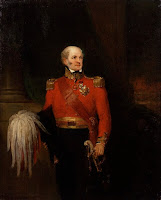BRITISH GENERAL
Sir John Lambert
Born: 28 April 1772 - Hampshire, England
Died: 14 September 1847 - Thames Ditton, Surrey, England.
Rank: General
Lambert was the son of naval officer, Captain Robert Lambert and mother Catherine Byndloss. Before his 19th birthday, Lambert entered the British Army on 27 January 1791, as an ensign in the 1st Foot Guards. He was promoted to lieutenant and captain on 9 October 1793. He served at the sieges of Valenciennes and Dunkirk, and was in the Battle of Lincelles in 1793. He was adjutant of the third battalion in the campaign of 1794, served with it during the Irish Rebellion of 1798, and in the expedition to Holland in 1799.
Lambert was promoted captain and lieutenant-colonel on 14 May 1801. He served in Portugal and Spain in 1808, and was present at Corunna, where he commanded the light companies of the guards in the Walcheren expedition of 1809. He became colonel in the army on 25 July 1810, and embarked for Cadiz in command of the third battalion on 30 May 1811. In January 1812, he was sent to Carthagena with two battalions. He remained there for three months, and in October he joined Wellington's army at Salamanca.
On 4 June 1813 he was promoted major-general, and was appointed to a brigade of the sixth division. He commanded at the battles of Nivelle, Nive, Orthez and Toulouse and was mentioned in despatches. He was awarded the Army Gold Cross and was made KCB on 2 January 1815.
Having been sent to America, he joined the army under Sir Edward Pakenham, at the Battle of New Orleans on 6 January 1815, with the 7th and 43rd regiments. In the unsuccessful attack on the American entrenchments, made two days afterwards, he commanded the reserve. Pakenham being killed, and General Gibbs mortally wounded, the chief command devolved on Lambert. He decided not to renew the attack, withdrew the troops which had been sent across the Mississippi, and retreating on the 18th, re-embarked his force on the 27th. He proceeded to Mobile Bay, where Fort Bowyer was taken on 12 February, and next day news arrived that a peace treaty had been signed.
Lambert returned to Europe in time to command the 10th brigade of British infantry at the Battle of Waterloo. The brigade joined the army from Ghent only on the morning of 18 June, and was at first posted in reserve at Mont St Jean. After 3 o’clock. it was moved up to the front line to support the 5th (Picton's) John Lambert's 10th Brigade in the 6th Division. At about 6:30 PM, the French captured the key strongpoint of La Haye Sainte farm. After this success, they brought up several cannon and took the Anglo-Allied lines under fire at extremely close range. At this period, the 698-strong battalion was deployed in square at the point where the Ohain road crossed the Charleroi to Brussels highway. At a range of 300 yards, the French artillery caused the unit enormous casualties within a short time. At day's end, the 1st Battalion had lost 105 killed and 373 wounded, a total of 478 casualties, without breaking. The unit was described as "lying dead in a square" the 1/27th (Inniskillings), suffered almost 500 out of a total of 747 killed and wounded, amongst the highest casualties of British regiments during the battle. In this number were sixteen out of the nineteen officers and twenty-three of the thrity-four Colour Sergeants and Sergeants, all killed or wounded. When, during the battle, only one officer remained standing.
Lambert was mentioned in Wellington's dispatch, and received the thanks of parliament, the order of Order of St Valdimir, 3rd class and also the Military Order of Max Joseph (commander). He commanded the 8th infantry brigade in the army of occupation in France.
In October 1816, he married Jane Morant, a daughter of John Morant of Brockenhurst Park, New Forest, England in which they had four children, John, Harriet Frances, Robert and Mary Jane.
He was promoted lieutenant-general on 27 May 1825, and general on 23 November 1841. He was given the colonelcy of the 10th regiment on 18 January 1824, and the Grand Cross of the Bath (G. C. B) on 19 July 1838.
Lambert was also an English amateur cricketer who made 12 known appearances in first-class cricket matches from 1794 to 1810. He was mainly associated with MCC (Marylebone Cricket Club)
Lambert died at Weston House, Thames Ditten, Surrey on 14 September 1847, aged 75. He is buried in the Holy Trinity Churchyard in Claygate Surrey.











.jpg)







(1).jpg)